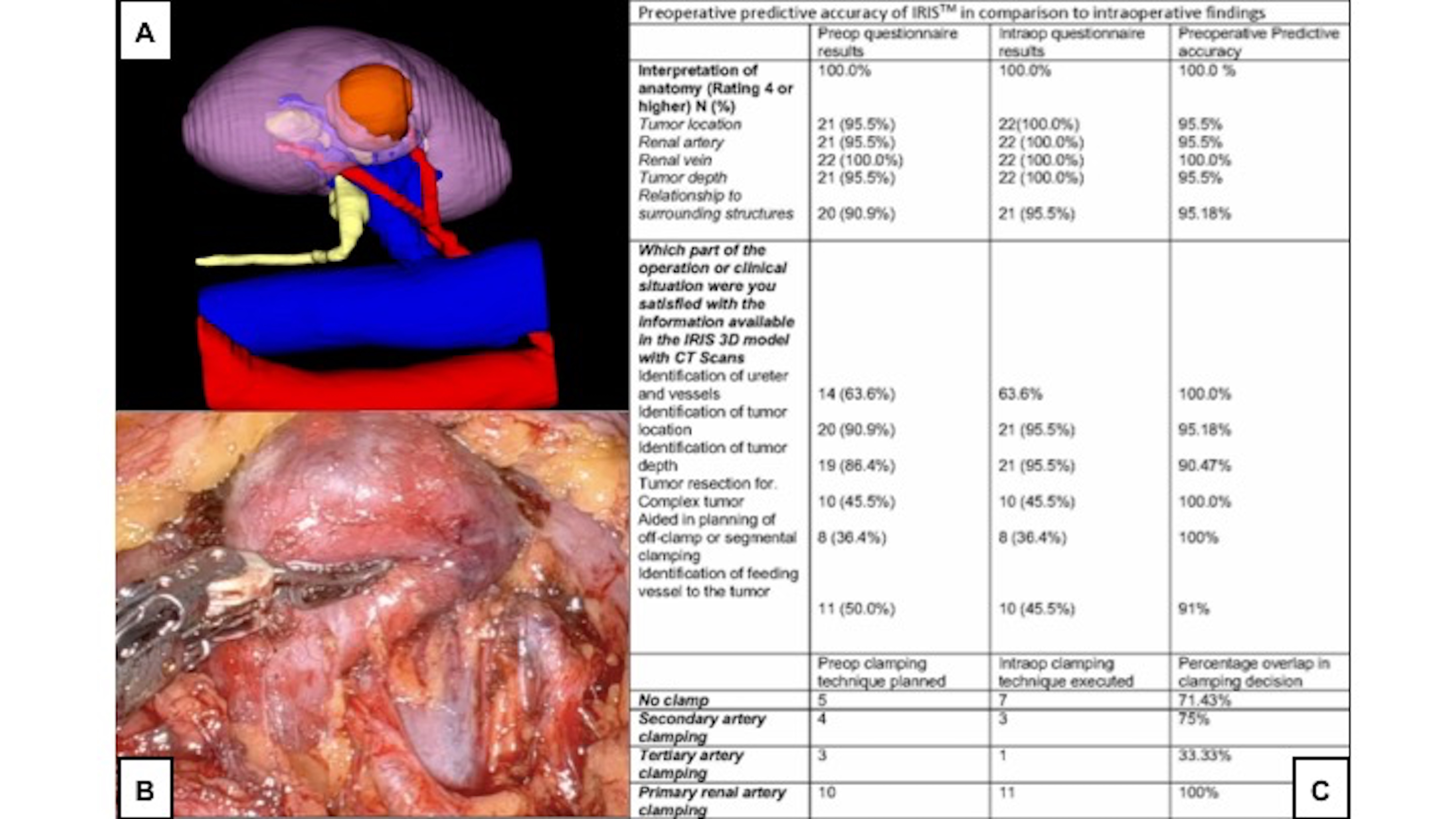Back
Poster, Podium & Video Sessions
Podium
PD37: Surgical Technology & Simulation: Instrumentation & Technology II
PD37-09: Predictive validity of IRISTM 3D anatomical models during Robot Assisted partial nephrectomy
Sunday, May 15, 2022
8:20 AM – 8:30 AM
Location: Room 245
Nitin Sharma*, Thomas Osinski, Thomas Frye, William Tabayoyong, Jonathan Bloom, Hani Rashid, Ahmed Ghazi, Jean Joseph, Rochester, NY
- NS
Nitin Sharma, MD
Clinical Fellow Endourology
Podium Presenter(s)
Introduction: Successful RAPN is dependent to a large extent on meticulous preoperative surgical planning, based on review of 2-Dimensional imaging. Several 3-Dimensional virtual reality digital imaging models have demonstrated a useful preoperative planning and intraoperative navigation tool during RAPN. However, no studies have assessed the differences in preoperative plan to intraoperative execution (i.e., Predictive ability). Primary objective of this study was to evaluate the correlation between preoperative plan utilizing IRISTM and actual intraoperative findings during RAPN.
Methods: 22 patients scheduled for RAPN were enrolled in a prospective study with 5 urologists. Prior to surgery, urologists reviewed the IRIS 3D model on an iOS app and completed a survey outlining their surgical plan including approach, and ischemia technique as well as confidence in executing this plan. Postoperatively, questionnaires assessing the procedural approach, clinical utility, efficiency, and effectiveness of IRISTM were completed (Fig 1A). The degree of overlap between the preoperative planned approach including clamping technique and the actual intraoperative execution was evaluated (Fig 1B). Questionnaires were answered based on 5-point Likert scale and score 4 or greater were considered positive.
Results: Median age was 64 years with mean tumor size of 29.6mm (17.5 mm-44.0mm). 21% were hilar tumors with 63% of patients having RENAL score 7 and above. On preoperative questionnaires, 100% of surgeons reported confidence in anatomical interpretation and >90% were confident that they can perform procedure as planned. There was 100% overlap between preoperative and intraoperative questionnaires for surgical approach, interpreting anatomical details and clinical utility (Fig 1C). When comparing plan of clamping vs off or selective clamping the preoperative plan was executed in (11/12 patients) (91.7%) of cases intraoperatively.
Conclusions: This is first study to evaluate clinical utility of IRIS during RAPN as well as to evaluate if preoperative anatomical details found on IRISTM models were sufficiently accurate during intraoperative execution. We found a great degree of overlap between preoperative clamping technique planned and actual clamping executed.
Source of Funding: Intuitive Surgical

Methods: 22 patients scheduled for RAPN were enrolled in a prospective study with 5 urologists. Prior to surgery, urologists reviewed the IRIS 3D model on an iOS app and completed a survey outlining their surgical plan including approach, and ischemia technique as well as confidence in executing this plan. Postoperatively, questionnaires assessing the procedural approach, clinical utility, efficiency, and effectiveness of IRISTM were completed (Fig 1A). The degree of overlap between the preoperative planned approach including clamping technique and the actual intraoperative execution was evaluated (Fig 1B). Questionnaires were answered based on 5-point Likert scale and score 4 or greater were considered positive.
Results: Median age was 64 years with mean tumor size of 29.6mm (17.5 mm-44.0mm). 21% were hilar tumors with 63% of patients having RENAL score 7 and above. On preoperative questionnaires, 100% of surgeons reported confidence in anatomical interpretation and >90% were confident that they can perform procedure as planned. There was 100% overlap between preoperative and intraoperative questionnaires for surgical approach, interpreting anatomical details and clinical utility (Fig 1C). When comparing plan of clamping vs off or selective clamping the preoperative plan was executed in (11/12 patients) (91.7%) of cases intraoperatively.
Conclusions: This is first study to evaluate clinical utility of IRIS during RAPN as well as to evaluate if preoperative anatomical details found on IRISTM models were sufficiently accurate during intraoperative execution. We found a great degree of overlap between preoperative clamping technique planned and actual clamping executed.
Source of Funding: Intuitive Surgical


.jpg)
.jpg)